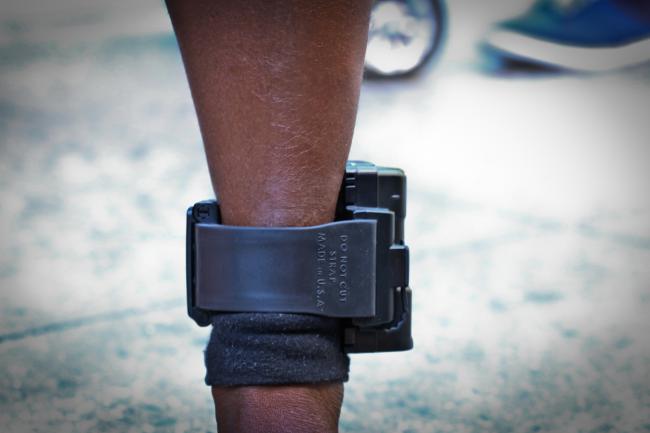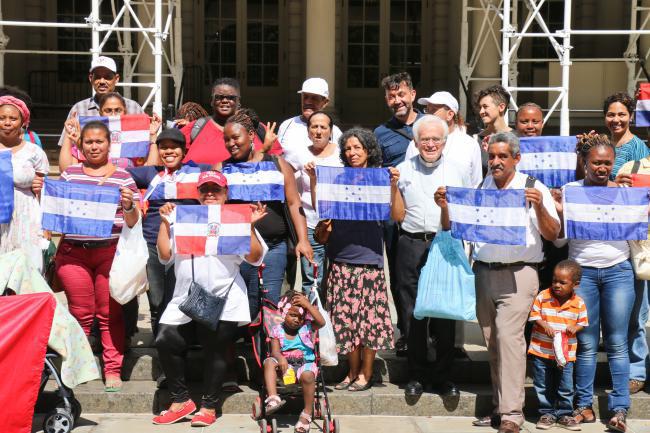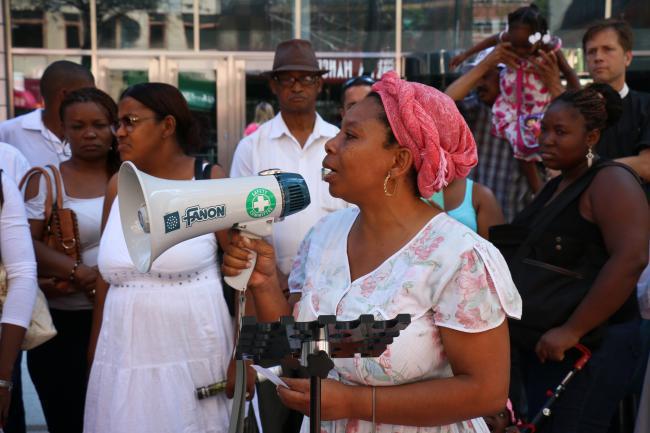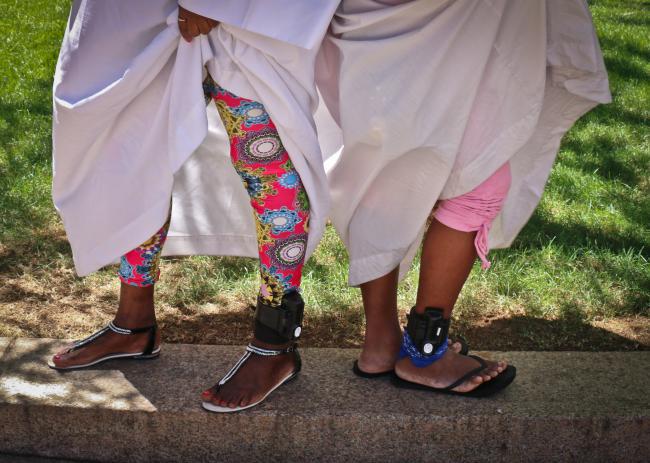
A month after having left her community of Roatán, on the Atlantic coast of Honduras, Adriana Colón arrived to the United States with her seven-year-old son José. She comes from one of the 54 Garífuna Honduran communities of indigenous and African descent living throughout Central America. Like many single mothers from the Garífuna community, she is part of a recent wave of migration that has left, fleeing the devastating sea of violence and marginalization that has swept through her country in recent decades. Presently, many Garífuna communities in Honduras are now facing a territorial crisis some see as the result of “Charter Cities” or tourist development that has come ashore in recent times, displacing people from their ancestral land through political and business pressure.
As soon as she arrived in New York City, Colón had an order to report to the Immigration Enforcement and Customs (ICE) building in downtown Manhattan. Colón walked with uncertainty into the looming 41-story building, past bulking DHS agents with rifles and body armor. “When I reported in, I didn’t have any idea what was going to happen to me,” explained Colón. Once in front of immigration officials, they placed an electronic monitor around her ankle for the misdemeanor of crossing the U.S. border without inspection. This ankle monitor program is increasingly seen as one that extends the surveillance and restriction of movement already established in immigration detention centers directly to people’s homes.
These electronic ankle monitors are part of ICE’s Alternatives to Detention (ATD) programs, which have been around since the 1990s and were expanded in 2004 with the launch of the Intensive Supervision Appearance Program (ISAP). This program is contracted out to the private corporation, Behavioral Interventions Incorporated (B.I.). In addition to managing private security for ICE, B.I. holds contracts with the incarceration industry to track and monitor those house arrest or awaiting trial.
The monitors are equipped with GPS capabilities to track a person’s movement and the location in near real time. They can broadcast pre-programmed audio messages (in English only), and require hours of recharging—while still on the body—every day. Those enrolled in ISAP must also comply with a series of requirements such as notification by phone, and home visits by a case specialist without prior warning to ensure they check-in at ISAP and make all court appearances. “I have even received visits from immigration officials at 6 am,” explains Berni Lara, a Garífuna woman who came to New York in July, “and it was only to ask me three things: how many children live in the house, their ages, and if we have pets.”
A major factor in the expansion of ISAP has been the economics behind Alternatives to Detention. According to Amy Gottlieb, an immigration attorney, while immigrant detention costs approximately $122 a day, supervision by the electronic ankle monitor costs the government about $20 a day.
Some have applauded ISAP’s expansion as a more humane way to treat immigrants. In the offices of B.I., a Garífuna woman, 19, held her child as the young employee of the contracted corporation refitted her ankle monitor after she failed to check into the ISAP office, in violation of the requirements. Although she had already worn the ankle monitor for the normal 90-day period, she was facing another three months under ISAP—at which point the employee told her she should be thankful, as the other option was detention. His sentiment is echoed by a number of immigration attorneys and immigrant rights advocates. Camille Mackler, of the New York Immigration Coalition, is currently advocating on behalf of those enrolled in ISAP, but she recognizes the difficulty in trying to challenge these policies while other immigrants are simply incarcerated. She explains, “Some lawyers are fighting tooth and nail to get their clients out of detention and enrolled in ISAP.”
Adriana Colón emigrated to the United States with the hope of finding a better future for her family. Here in New York, she regularly attends meetings with other Garífuna women who have ended up in the Bronx. Sitting at a church where these gatherings take place, Colón explains, “I left my community because of the violence and also because there are no job opportunities.” Indeed, Honduras has the highest murder rate in the world. Many of the Garífuna women who come to this church in the Bronx consistently cite the impuesto de guerra—or war tax—as a reason they fled their homes. This tax is a form of extortion that gang members demand, going door to door and threatening to kill entire families that don’t comply with handing over recurring payments to the gang. Many of the women share stories about the violent demise of those who have failed to pay.

For many Hondurans, the journey to New York begins with a bus ride to the border town of Tecún Umán, Guatemala. Migrants then go by raft over the Suchiate River, and “once in Mexico,” explains Colón, “the objective is to reach Ixtepec, Oaxaca, and to board La Bestia. Atop the train you can see everything—the muggings of Los Zetas, people falling.” A common route for crossing the U.S. border is at Piedras Negras, Coahuila, and it involves swimming across the Rio Grande by night, in the cold, fighting against the current. This entire journey is particularly risky for women, 60% of whom experience sexual violence before making it to the United States.
When Colón and a group of Garífunas from her community crossed the Rio Grande into Texas, “the border patrol was already waiting,” she said. During the night they were detained along with their children in a cold room without food. Immigration officials made them sign a pair of documents that they could not understand because they were in English. The next day, they were allowed to leave on the condition that they report to immigration court at their destinations.
Sonia Cruz, who regularly attends the meetings with other Garífuna women at a church in the Bronx, describes her experience: “When la migra detains you when you come with your children, they don’t deport you, but they digitally take your fingerprints. They collect your name and the personal information of the person who is going to take responsibility for you in the United States. In this case, it was my sister in New York. So once you are released, you can’t flee because they have all of your and your family’s information. You are on their radar.”
Colón describes the day that she began wearing the electronic ankle monitor, or grillete—Spanish for “shackle.” “Before they fitted me with the shackle, the immigration officials put on a video to explain how the monitor should be used. That is the only information that they gave me,” explains Colón.
Zoila Hernández, from the Tornabé Garífuna community in Honduras, recalls that when the immigration official fitted her with the shackle, he said, “Welcome, you have just voluntarily entered the ISAP program,” but she had never been asked if she agreed to participate. She believes she unknowingly gave consent when the immigration officials on the border compelled her to sign consent forms to participate in the program, without explaining what type of documents she was actually signing. Many of the Garífuna women meeting at the church in the Bronx explained that during their first visit to ICE and the ISAP offices, they were never informed about the reasons that they were given ankle monitors or when they would be removed. Many also explained that they did not even know that they were going through deportation proceedings.
The use of the ankle monitors requires a period of physical adjustment, causing swelling of the foot and leg, as well as severe cramps. The person must be tethered to an outlet as the device is charged for hours, twice every day. “Although it is plastic and lightweight, it still causes my foot to swell, and it becomes very hot when it is being recharged,” said Zully García.
The greatest challenge that people under ISAP face with the use of the monitor is the psychological effects. The international coordinator of the Honduran solidarity group OFRANEH, Carla Garcia, explains that for her, the shackle conjures up the brutal history of her people in the Americas. “We the Garífunas were slaves, and we freed ourselves. We are a community that fought against the colonizers, and then this type of program makes us remember our history. Just as before they placed the slaves in iron chains, now in the capitalist economy our chains are electronic.”

María Asunción commented, “I feel like an animal, because only animals are treated like this. My son asked me why they put this on me, he said that they only do this to thieves. I explained to him that I am not a thief.” Asunción, who emigrated with her young daughter from Honduras and now presently lives in the Bronx, has been an active leader fighting against the use of electronic ankle monitors.
Adding to the social stigma, many of the Garífuna women have expressed shame in wearing the ankle monitors. During the summer, the women preferred to wear long clothes that would cover their ankles in order to not call attention to themselves in the street. “Using the shackle is torture. When you go out into the street, the whole world stops to look at your feet. A few days ago the police stopped me and asked if I had been a prisoner. I told them that I had not, and they answered, then why do you wear this ankle monitor. They only put those on prisoners who have committed a crime. I felt very bad,” recalls Zully Garcia, who traveled 26 days from her home in Honduras before finally crossing into the United States at the Texas border.
ISAP also prevents migrants from working while moving through the deportation process, and the Garífuna women face a difficult and precarious economic situation. The majority of recently arrived migrants have not paid off the debt to their “coyote,” or human smuggler.
In 2012, Rutgers Law School and the American Friends Service Committee released a report criticizing ICE for inconsistent, arbitrary, and unclear criteria for enrolling people in ISAP. The report calls into question the “alternative” aspect of the program, saying, “many ATD programs are used on individuals who have been released from detention or who were never detained in the first place, rather than individuals who would otherwise be detained in a detention facility.”
ICE released guidelines in 2009 stipulating that immigrants should be released from detention “so long as the alien's identity is reasonably known and the alien does not present a danger to the community or a significant risk of flight.” However, in 2011 ICE considered that 89% of the individuals under ISAP were not violent or dangerous. In this community in particular, the single mothers taking care of young children hardly seem to pose a “danger to the community.” Yet the fear that they present a “significant risk of flight,” overall statistics reflect that most immigrants— 85% to 89% over the last five years—in removal proceedings show up to their hearings. There is no reason to think that these women are any different than the greater population more generally, and, in fact, as women with young children they should be less likely to be dangerous or pose a flight risk. Nevertheless, according to Carla García, save for the women who are pregnant, “From what I have seen from the women I have been organizing with in the Bronx, 100% of those who arrived over the summer [of 2014] were fitted with the shackles.”
Many of the Garífuna women feel that they have been singled out in the immigration system for the use of ankle monitors, wondering if the color of their skin is seen as a “threat to the community.” Colón recalls that “in the waiting room, about 90% of the migrants that were there were single mothers with their children, the majority from the Honduran Garífuna community.” According to Carla Garcia, from OFRANEH, approximately 400 women from the Garífuna community who have emigrated to New York are enrolled in ISAP. This is out of 17,454 people nationwide under ISAP in 2011.

While there is no hard evidence that this community has been specifically targeted—”they may just be more vocal,” explains Mackler, from New York Immigration Coalition—their enrollment in ADT is part of the overall expansion of the immigration-incarceration-industrial complex.
Just as the United States holds the top spot for the highest incarceration rate in the world, it is believed that the United States detains a higher number of immigrants than any other country. In 1994, daily detention capacity was 6,784 and this had increased to 34,000 in 2011, with a record number of 429,000 people detained that year. Alternative forms of detention should be included in the critique of this expansion over the last two decades. While it is not hard to argue that ISAP is a preferable alternative to the mass incarceration that has been the growing enforcement option over the last decades, criticism to programs like “Alternatives to Detention” and ISAP should not be overlooked simply because the standard for addressing our hemispheric migration problem has been set so low, offering only degrading and dehumanizing treatment for people who pose no threat to the community. Dismissing complaints about electronic ankle monitors in the shadow of mass incarceration obscures the fact that ADT is part of this very same industry-driven expansion.

Kyle Barron graduated with an MA in Politics at New York University, and is an organizer with the New Sanctuary Coalition NYC. Follow her @KyleBarron138.
Cinthya Santos Briones is a community organizer and a freelance journalist in New York. She has worked as a researcher and photographer at various institutions in Mexico and New York, having studied Anthropology and Ethnohistory. Since 2007 she has worked in New York with indigenous Otomis, Nahuas, and Tepehuas migrants from the Sierra Veracruzana.

